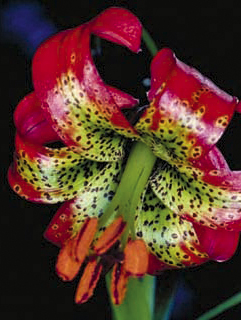(Lilium occidentale)
 Lilium occidentale. Photo © John Game.
Lilium occidentale. Photo © John Game.
 Lilium occidentale. CDFW illustration by Mary Ann Showers. (Click to enlarge)
Lilium occidentale. CDFW illustration by Mary Ann Showers. (Click to enlarge)
Western lily is a California endangered plant species, which means that killing or possessing plants from the wild is prohibited by the California Endangered Species Act (CESA). It is also listed as endangered under the federal Endangered Species Act(opens in new tab). Western lily is a perennial plant that grows from a bulb and occurs in coastal areas between Coos Bay, Oregon, and Eureka, California. It has crimson red flowers with yellow centers that produce both pollen and seeds. It is primarily pollinated by hummingbirds, but is also visited by bees and other insects.
Western lily has been the subject of many research projects and conservation efforts due to its charismatic flowers and unique habitat type. There are well-studied populations on two CDFW properties: Table Bluff Ecological Reserve in Humboldt County, which has a management plan (PDF), and Crescent City Marsh Wildlife AreaCrescent City Marsh Wildlife Area(opens in new tab) in Del Norte County, which has a monitoring plan (PDF). Western lily plants at the more southern Table Bluff occurrences have been observed blooming later in the year than the northern populations. Plants exposed to prolonged flooding at the Crescent City Marsh population have been observed emerging later than other populations, and may not reproduce each year.
Western lily is threatened by development, encroachment and hydrological modification from land use changes. Overgrazing was listed as a threat in the past, but there is evidence that some grazing can be beneficial because western lily seeds are not digested by cattle, and grazing reduces competition from other species. The largest threat to western lily is successional change in vegetation composition resulting in encroachment by shrubs and trees due to a lack of ecological disturbance such as fire. Impacts from nonnative species invasions, lack of genetic diversity due to small population sizes, over-utilization for the commercial nursery trade and climate change also threaten western lily.
In order to ensure the continued existence of western lily, management strategies must include appropriate disturbance regimes across its range. Options for disturbance include controlled burns, manual vegetation removal, and reintroduction of controlled cattle or goat grazing. The drainage at Crescent City Marsh, which supports the largest remaining population of western lily, should be improved in order to prevent further decline of the population. For a complete list of recommended conservation actions at sites in both California and Oregon, refer to the 2009 U.S. Fish and Wildlife Service’s Five Year Review (PDF).
CDFW has participated in the following Western lily studies and papers through participation in the Cooperative Endangered Species Conservation Fund(opens in new tab) or other mechanisms:
CDFW may issue permits for western lily pursuant to CESA, and you can learn more about the California laws protecting western lily and other California native plants. Populations of western lily occur in CDFW’s Northern Region. More information is also available from the U.S. Fish and Wildlife Service Species Profile for Western lily.(opens in new tab)
Updated 6/24/14